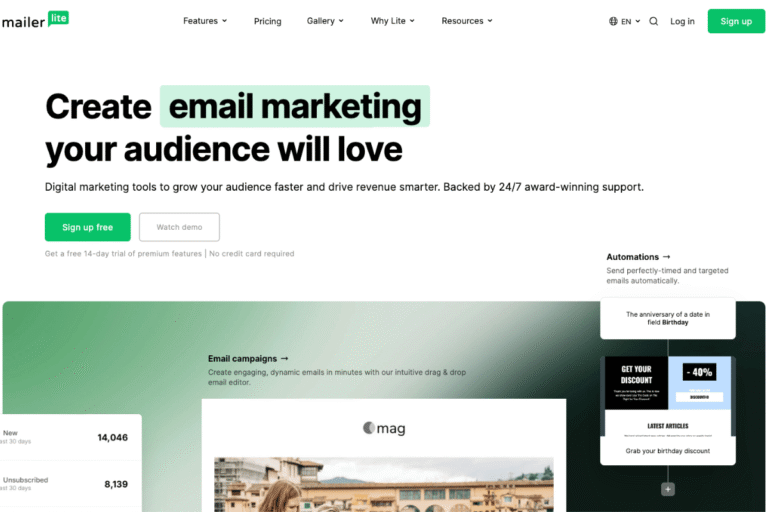You don’t need a giant tech stack or a 20-person team to turn email into a sales engine. You need the right workflows, clean data, and messages that show up at the right moment. In this guide, you’ll learn how to use email automation for sales, step by step, with proven workflow blueprints, smart personalization, and testing tactics that compound your conversions.
We’ll use familiar tools like MailerLite, Mailchimp, and ConvertKit as examples, with practical tips, pros and cons, simple setup steps, and real-world use cases. By the end, you’ll have a clear plan to build and optimize automation that actually drives revenue, without annoying your list.
Define Your Sales Goal And Map The Customer Journey
Identify Stages And Micro-Conversions
Start with one clear sales outcome. Examples:
- Book 10 demos/month for your agency
- Sell 50 seats for your cohort course
- Generate $5,000/mo from a 3-product ecommerce bundle
Now map the path someone takes to get there. Think like a customer, in stages:
- Awareness: discovers your brand via a blog, ad, or referral
- Consideration: opts in, reads guides, compares alternatives
- Evaluation: attends webinar, downloads a sample, starts a trial
- Decision: buys, books, or subscribes
- Post-purchase: uses, reviews, refers, buys again
Micro-conversions keep the journey moving:
- Opt-in to a lead magnet
- Click a product link or pricing page
- View cart or start checkout
- Start a trial or book a call
- Use a feature, complete onboarding task
You’ll use these micro-conversions as triggers and milestones inside your automations.
Inventory Data, Events, And Triggers You Can Track
List what your tool can capture out of the box and what you can add:
- Subscriber data: name, company, tags, segments, lead source, plan/tier
- Behavioral events: signup, link clicks, page views (via site tracking), purchases, cart events, video views, webinar attendance, feature use
- Lifecycle fields: first seen, last seen, last engaged email, customer tenure, last purchase date, average order value
Tool notes (quick wins):
- MailerLite: straightforward site-tracking + ecomm integrations: tags/segments are simple to manage.
- Mailchimp: strong ecommerce data via Shopify/WooCommerce: Customer Journey builder supports multi-branch logic.
- ConvertKit: excellent tag-first model for creators: powerful link triggers and conditional content.
Align Offers And CTAs To Each Stage
Match your ask to readiness:
- Awareness → CTA: “Get the guide” or “Try the template” (no hard sell yet)
- Consideration → CTA: “See a demo”, “Compare plans”, “Watch the 5‑min walkthrough”
- Evaluation → CTA: “Start free trial”, “Book a strategy call”, “Add to cart”
- Decision → CTA: “Checkout with bonus”, “Enroll before price increase”
- Post‑purchase → CTA: “Activate feature X”, “Leave a review”, “Refer a friend”
Pro tip: Define one primary CTA per email and one “soft alternate” (e.g., reply to ask a question). Keep momentum, minimize friction.
Prepare Your List And Data Foundation
Core Segments, Tags, And Lead Source Tracking
Clean segmentation = better conversions. Start with:
- Lifecycle segments: Subscribers, Leads, MQLs, Customers, Repeat Customers, Lapsed
- Interest/intent tags: Product A interest, Pricing page visitor, Webinar attendee
- Acquisition source: Facebook Ad – Lead Magnet X, SEO – Blog Y, Partner – Webinar Z
How-to quick-start in popular tools:
- MailerLite: Create groups for lifecycle: use tags for interests: capture lead source via hidden fields on forms.
- Mailchimp: Use “Tags” for interest, “Segments” for dynamic filters (e.g., last opened within 30 days): add UTM-based automation to tag source.
- ConvertKit: Rely on tags for everything: auto-apply tags via link triggers and form-specific tags.
Consent, Preferences, And Profile Enrichment
- Add a simple preferences center (topics, frequency). Let people opt down vs. opt out.
- Capture enrichment lightly over time: industry, role, product use case. Use progressive profiling in forms or by asking one question in a PS.
- Respect consent: record timestamp/URL of opt-in, honor GDPR/CCPA and CAN‑SPAM.
Deliverability Basics: Hygiene, Sunset Policies, And Authentication
- Authenticate your domain: SPF, DKIM, and DMARC (at minimum p=none if you’re starting: tighten later). This protects your reputation and helps inboxing.
- List hygiene: verify imports, remove hard bounces, suppress complainers.
- Sunset policy: if a contact hasn’t opened/clicked in 90–180 days, move them to a re‑engagement path, then suppress.
- Keep sends predictable. Big volume spikes often land you in Promotions or worse.
Pricing snapshot (always check current rates):
- MailerLite: Free up to ~1,000 subscribers (limited): paid from ~$10/mo for 1,000.
- Mailchimp: Essentials from roughly ~$13/mo for 500 contacts: Standard higher.
- ConvertKit: Free up to ~1,000 (limited): Creator from ~${29}/mo for 1,000.
Try them here (affiliate): MailerLite – yoursite.com/go/mailerlite, Mailchimp – yoursite.com/go/mailchimp, ConvertKit – yoursite.com/go/convertkit.
Automation Building Blocks: Triggers, Logic, And Actions
Common Triggers (Signup, Purchase, Page View, Link Click)
Pick triggers tied to intent:
- Signup/Tag added: lead magnet opt‑in, webinar registration
- Page view: pricing page, features page, cart
- Link click: product interest, demo video
- Purchase/Cart events: added to cart, abandoned, purchased SKU X
- Lifecycle timing: last engaged >30 days, trial day 3
Logic Paths: Delays, Conditions, Branching, And Goals
- Delays: give people time to act (e.g., 1–3 days between nurture emails).
- Conditions: if trial user hasn’t activated feature X → send activation tips.
- Branching: split paths by interest (clicked A vs. B), lead source, plan.
- Goals: in tools like Mailchimp and MailerLite, set a goal (e.g., Purchase). When achieved, exit or jump ahead to post‑purchase.
Actions: Send, Update Fields, Score Leads, Notify Sales, Webhooks
- Send email or series
- Update tags/fields (e.g., “Interested in Product A”)
- Lead scoring (add points for behaviors: threshold → notify sales)
- Internal alerts: send Slack/Email to sales when high intent is detected
- Webhooks: push to CRM/checkout, trigger custom events
Pros and cons quick take:
- MailerLite: Pros, easy builder, fair pricing: Cons, advanced scoring/reporting lighter than enterprise tools.
- Mailchimp: Pros, mature ecomm data, visual journeys: Cons, can feel complex, pricing scales with contacts.
- ConvertKit: Pros, creator-friendly, powerful tagging/conditional content: Cons, limited native ecommerce beyond simple products unless integrated.
High-Converting Workflow Blueprints
Welcome + Lead Nurture Sequence (From Opt-In To First Purchase)
Goal: turn a new subscriber into a customer within 7–21 days.
Suggested 5–7 email arc:
- Delivery + Quick Win: deliver the lead magnet immediately: give one practical tip they can finish in 10 minutes: ask a 1‑click preference question (A/B interest link).
- Story + Problem Agitation: origin story: show the cost of staying stuck: link to a case study.
- Teach + Soft Offer: tutorial or checklist: soft pitch entry product or trial.
- Social Proof + Objection Handling: testimonials, FAQ, what happens after purchase.
- Direct Offer + Risk Reversal: clear CTA, bonus, guarantee, time‑bound incentive.
6–7) Optional: Compare solutions, live Q&A invite, or mini‑demo.
Tool tips:
- MailerLite: Use groups to move buyers out of funnel automatically.
- Mailchimp: Set a Journey goal (Purchase) to auto-exit purchasers.
- ConvertKit: Use link triggers to branch by interest.
Abandoned Cart And Browse Abandonment (Ecommerce)
Cart Abandonment (send 2–3 emails over 24–48 hours):
- 1: Reminder + Image of items + Clear checkout CTA
- 2: Overcome friction: shipping, returns, sizing: show UGC
- 3: Incentive (optional): small discount or bonus: include deadline
Browse Abandonment (no cart yet):
- 1: “Still considering?” with top benefits and related products
- 2: Social proof and buying guide link
Key: suppress if purchased: personalize with product names/variants.
Onboarding And Activation (Courses, SaaS, Services)
Aim: first value within 24–72 hours.
- Day 0: Welcome + 3‑step quick start checklist
- Day 1–3: Feature spotlight tied to promised outcome: short video
- Day 4: Nudge to complete key action: offer live help or office hours
- Day 7: Success milestone celebration: invite to community
- Day 14: Case study + upgrade/retainer offer if activation achieved
Add conditions: if user completes activation earlier, skip nudges and move to advanced tips.
Product Launch Or Waitlist Warm-Up
Phases:
- Tease: problem stories, behind-the-scenes, transformation promise
- Proof: beta results, testimonials, demo clips
- Open Cart: clear pricing, bonuses, dates, FAQ email, risk reversal
- Close: reminders with ethical urgency: add webinar/live Q&A
Split paths by engagement. Hot leads get fewer emails but earlier direct offers.
Post-Purchase: Cross-Sell, Upsell, And Review/Referral
- T+2 days: How to get the most from purchase: setup guide
- T+7 days: Complementary product cross-sell or upgrade
- T+14 days: Review request with shortcut link and incentive
- T+21–30 days: Referral ask with simple copy customers can forward
Re-Engagement And Win-Back
For unengaged 90–180 days:
- Subject: “Still want [topic]?” Offer a frequency downgrade or topic change
- Send a “best of” digest or new lead magnet
- Last chance: “We’ll pause emails unless you click to stay”
If no activity, suppress to protect deliverability.
Real‑world use cases:
- Blogger selling templates: welcome → mini‑course nurture → product intro → launch week
- Shopify brand: browse + cart abandonment → post‑purchase review → replenishment reminder
- Freelancer: lead magnet → case study → strategy call booking → proposal sequence
Try a ready-to-use workflow in your tool (affiliate): MailerLite templates – yoursite.com/go/mailerlite, Mailchimp Journeys – yoursite.com/go/mailchimp, ConvertKit Visual Automations – yoursite.com/go/convertkit.
Personalization That Drives Action
Behavioral Targeting And Lead Scoring
- Assign points: +5 for pricing page, +3 for webinar attended, +10 for trial started, +20 for checkout started.
- Thresholds trigger actions: score ≥30 → send comparison guide: score ≥40 → notify sales or invite to demo.
- Decay scores over time, so old activity doesn’t mislead.
Dynamic Content And Conditional Blocks
Show different offers per segment within the same email:
- If tag = “Course Creator” → pitch cohort program
- If tag = “Ecommerce” → pitch analytics app
- If customer = true → hide entry-level offers, show add‑ons
MailerLite, Mailchimp, and ConvertKit all support conditional blocks or liquid-like logic. Keep rules simple: test rendering for each segment.
Using UTMs And Site Events For Contextual Offers
- Add UTMs to every CTA so you can attribute sales to specific emails.
- Trigger follow-ups from key site events (e.g., viewed /pricing twice in 7 days → send comparison matrix).
- Pass UTMs to checkout to tie revenue back to campaigns and automation paths.
Craft Messages That Convert
Offer Strategy, Objection Handling, And Risk Reversal
Offer clarity beats cleverness. Make the value obvious:
- Define the outcome: “Get your first 1,000 subscribers in 30 days”
- Stack the value: core offer + bonus + guarantee
- Handle top objections head-on: time, risk, fit, complexity, price
- Risk reversal: free trial, money-back guarantee, or “cancel anytime”
Subject Lines, Preview Text, And From Names
- Subject lines: be specific, curiosity-driven, or benefit-first. Examples:
- “Your cart’s still open, here’s a sizing tip that helps”
- “3 templates to speed up proposals (download inside)”
- Preview text: continue the story, don’t repeat the subject.
- From name: use a real person + brand (“Maya at BrightCo”). Consistency builds trust.
Email Structure: Hook, Value, Proof, CTA
- Hook: one-liner that promises a payoff
- Value: short teaching moment, checklist, or demo gif
- Proof: testimonial, data point, screenshot
- CTA: one clear action, button + text link backup
Short copy performs well for low-friction asks (webinar, trial). Use longer copy for higher-ticket decisions (coaching, enterprise).
Ethical Urgency, Scarcity, And Social Proof
- Time-bound bonuses, limited seats, or seasonal pricing, only if real.
- Social proof: customer logos, star ratings, review snippets, “X sold” counters.
- Respect inboxes: remind, don’t badger. Offer a snooze/opt-down during launches.
Timing, Cadence, And Safeguards
Pacing And Send-Time Optimization
- Welcome/nurture: 2–3 days between sends: closer spacing during launches.
- Cart/trial: tighter cadence (hours to 1 day) while intent is high.
- Use send-time optimization if available: otherwise test your top time windows (often weekday mornings in your audience’s time zone).
Pressure Valves: Pauses, Snooze, And Exit Criteria
- Add global limits (e.g., max 1 promo per day per contact).
- Offer a Snooze link for launch weeks (pause 7 days, then resume).
- Exit on goal reached (purchase, booked call) to prevent over-sending.
- Mutual exclusivity: stop other promos when a contact enters a high-priority journey.
Quiet Hours And Compliance Considerations
- Respect quiet hours by local time zone when possible.
- Include physical address and easy unsubscribe in every email.
- Honor data rights: let users access, edit, or delete their info on request.
- Some regions (e.g., EU) restrict cold email: stick to consent-based lists.
Measure, Test, And Optimize
Core Metrics And Sales Attribution
- Delivery health: bounce rate, spam complaints, inbox placement trends
- Engagement: open rate (directional), click rate, click-to-open rate
- Intent: product page views after email, trial starts, cart adds
- Revenue: average order value, revenue per recipient, time to first purchase
- Attribution: use UTMs, discount codes, and native ecommerce tracking
A/B Testing Plans For Emails And Paths
Test one variable at a time:
- Subject vs. preview text first: then CTA/button copy: then content length
- Offer framing: discount vs. bonus vs. guarantee focus
- Timing: delay lengths, send-time windows
- Path logic: branching by interest vs. lead source
Run for statistical confidence (or at least a few thousand sends when possible). Keep a living doc of what wins for your audience.
Workflow Health Audits And Debugging
Monthly checklist:
- Are triggers still firing? (form IDs, tags, site tracking)
- Are goals and exits working? (no double-sending after purchase)
- Are suppression rules preventing over-send?
- Do dynamic blocks render for each segment?
- Are links tracked with UTMs and resolving?
If performance dips:
- Check deliverability (auth records, reputation, list hygiene)
- Reduce frequency temporarily, improve value density
- Refresh creative: new subject lines, tighter copy, fresh proof
Tool-specific visibility:
- MailerLite: clear path analytics and email-level engagement
- Mailchimp: Journey analytics + ecomm revenue reporting
- ConvertKit: per-email sales (if using ConvertKit Commerce) and tag-based filtering
Want help picking a platform? Try MailerLite, Mailchimp, or ConvertKit with our affiliate links: yoursite.com/go/mailerlite, yoursite.com/go/mailchimp, yoursite.com/go/convertkit.
Conclusion
Building revenue-driving automation isn’t about fancy tricks. It’s about aligning a clear sales goal with a mapped journey, clean data, and timely messages that remove friction. Start with one workflow, usually a welcome + nurture or abandoned cart, ship it, then iterate. Layer in behavioral targeting, smarter offers, and stronger proof. Protect deliverability, test deliberately, and always exit people as soon as they convert.
Pick a tool that fits how you sell and how you like to work. If you want simple and budget-friendly, MailerLite is a great start. If you need deep ecommerce data, Mailchimp shines. If you’re a creator who lives on tags and sequences, ConvertKit feels natural. Ready to turn emails into revenue? Try one today (affiliate): yoursite.com/go/mailerlite, yoursite.com/go/mailchimp, yoursite.com/go/convertkit, and build your first automation this week.
Frequently Asked Questions
What’s the first step to use email automation for sales?
Start by defining one clear sales goal (e.g., book 10 demos/month), then map the customer journey from awareness to post‑purchase. Identify micro‑conversions—opt‑ins, pricing clicks, cart views—that signal intent. These become your automation triggers and milestones, ensuring messages match readiness and move prospects toward that single outcome.
How do I turn micro‑conversions into automation workflows for conversion?
Tie triggers to key behaviors (signup, pricing page view, cart add, purchase). Use delays, conditions, and branching to personalize paths. Align CTAs to each stage—guide in awareness, demo/trial in evaluation, checkout at decision. Set goals to auto‑exit on purchase, update tags/lead scores, and notify sales when intent spikes.
Which tool is best for sales automation—MailerLite, Mailchimp, or ConvertKit?
Choose based on your model. MailerLite: simple builder, fair pricing, solid site/ecommerce tracking. Mailchimp: robust ecommerce data and visual Customer Journeys, but can feel complex. ConvertKit: creator‑friendly tagging and conditional content, lighter native ecommerce. All support triggers, segments, and conditional blocks—pick the one that fits your workflow.
How often should I send automated sales emails without annoying subscribers?
For welcomes/nurture, space sends every 2–3 days. Use tighter cadence for carts and trials (hours to 1 day) while intent is high. Add global limits, snooze options, and exit criteria after conversions. Respect quiet hours, keep one primary CTA per email, and run re‑engagement/sunset policies for inactive contacts.
How long before email automation for sales shows ROI?
Many see first revenue wins within 2–4 weeks from a well‑built welcome+nurture or abandoned cart flow. Full ROI depends on list size, offer price, and traffic. Accelerate results by tightening targeting, aligning CTAs to stages, and measuring revenue per recipient and time‑to‑first‑purchase with UTMs and ecommerce tracking.
Does Apple Mail Privacy Protection impact sales automations, and how should I adapt?
Yes—opens are inflated, so treat open rate as directional. Prioritize clicks, on‑site events, trials, carts, and revenue. Authenticate your domain (SPF, DKIM, DMARC), keep list hygiene, and use behavior‑based triggers (pricing views, link clicks). Optimize for click‑to‑open and conversions, not opens alone, to maintain reliable automation logic.


